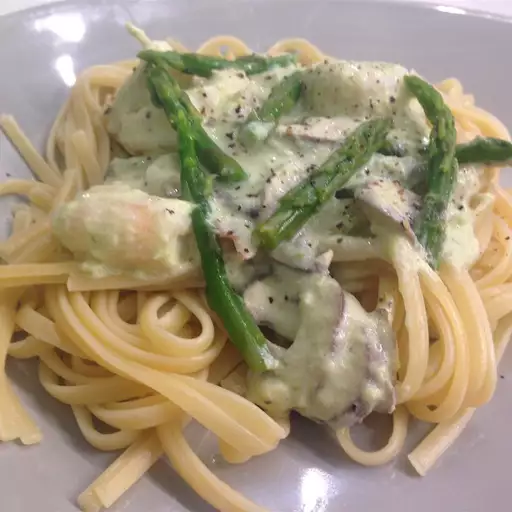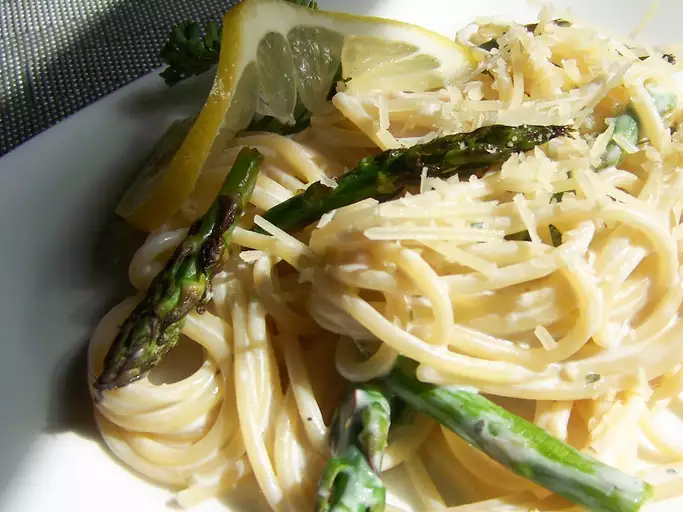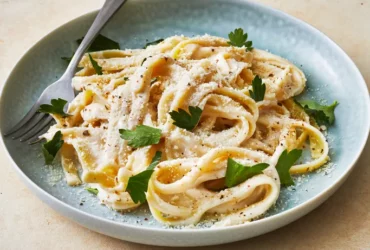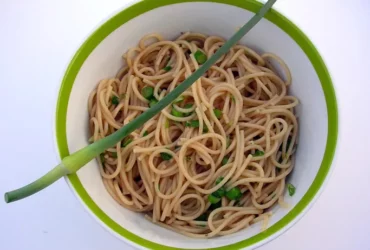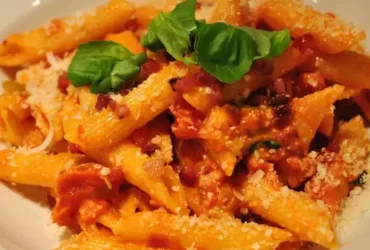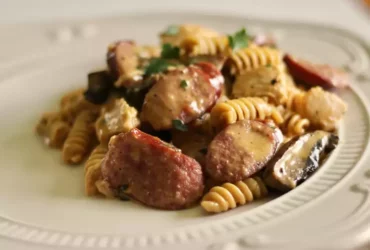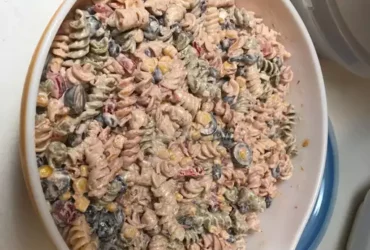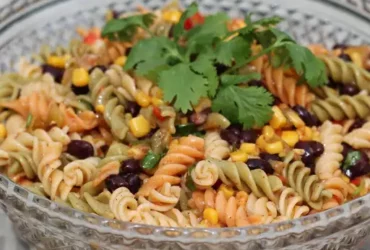Ingredients
Fresh Asparagus Spears: 1 pound
Asparagus, a popular vegetable, is often consumed during the spring season when it’s in peak freshness. Fresh asparagus spear is typically harvested in early spring and has a tender, sweet flavor profile.
The spears are usually sold in bunches or wrapped in plastic wrap at most supermarkets. When selecting fresh asparagus, look for spears that have tightly closed buds at the tip and a vibrant green color. The thickness of the spear can vary depending on the variety and growing conditions.
A 1-pound package of fresh asparagus spears usually contains around 16-20 spears, each measuring approximately 6-8 inches in length. The average thickness of a fresh asparagus spear is about 0.5-1 inch.
The nutritional value of fresh asparagus spears makes them a great addition to a healthy diet. They are low in calories and rich in vitamins A, C, and K, as well as folate and fiber. Fresh asparagus spear is also a good source of antioxidants.
The texture of fresh asparagus spears can range from tender to slightly crunchy, depending on the cooking method and desired level of doneness. When cooked, the natural sweetness of the vegetable becomes more pronounced.
When preparing fresh asparagus spear, trim the ends of each spear by cutting about 1-2 inches off using a sharp knife or kitchen shears. This helps to remove any tough or fibrous parts and promotes even cooking.
For the Creamy Asparagus Pasta Recipe, use 1 pound of fresh asparagus spears, trimmed, and cut into 1-inch pieces. The recipe will guide you through the steps for cooking and preparing this delicious dish.
Large Onion: 1, thinly sliced
In this recipe for Creamy Asparagus Pasta, one large onion is used as an essential ingredient to add flavor and texture.
The onion should be thinly sliced to release its natural sweetness and allow it to caramelize evenly in the pan.
Why Choose a Large Onion?
A larger onion provides more surface area for caramelization, which enhances the overall flavor of the dish.
Additionally, the sweetness of the large onion balances out the bitterness of the asparagus and the creaminess of the sauce.
Preparation Method
To thinly slice a large onion, follow these steps
- Peel the onion and place it on a stable surface.
- Position the knife at an angle to create even slices.
- Cut the onion in a smooth, continuous motion from top to bottom.
This will result in thinly sliced onions that are ready for use in the Creamy Asparagus Pasta Recipe.
Garlic Cloves: 4, minced
Garlic cloves play a crucial role in many recipes, including the Creamy Asparagus Pasta Recipe. The four minced garlic cloves add an aromatic flavor that complements the other ingredients perfectly.
To utilize the garlic effectively in this recipe, follow these steps
- Peel the four garlic cloves using a sharp knife to remove any excess skin.
- Mince each garlic clove into small pieces using a chef’s knife or a food processor.
The minced garlic should be evenly sized and not too fine, as this can lead to overpowering the other flavors in the dish. The goal is to achieve a balance of flavors in the Creamy Asparagus Pasta Recipe.
When mincing the garlic, consider using a microplane grater for added efficiency. This tool will help you produce an even texture and make it easier to measure out the correct amount of minced garlic.
To incorporate the minced garlic into the recipe, add it to the skillet with butter or oil when sautéing the asparagus. The heat from the pan will caramelize the garlic and create a rich, savory flavor that elevates the dish.
Pesto Cream Sauce Mix (homemade or store-bought): 1 jar
Pesto Cream Sauce Mix is a fundamental component of the Creamy Asparagus Pasta Recipe, adding an incredible depth of flavor to the dish. For those who wish to make their own Pesto Cream Sauce Mix from scratch, a combination of basil leaves, garlic cloves, pine nuts or walnuts, grated Parmesan cheese, and extra virgin olive oil can be blended together with a squeeze of fresh lemon juice.
The ingredients for homemade Pesto Cream Sauce Mix may vary depending on personal preferences. For instance, some individuals might prefer the use of freshly ground black pepper while others might choose to substitute pine nuts with walnuts or almonds. The key is to balance the flavors and textures to create a well-rounded and delicious sauce.
On the other hand, store-bought Pesto Cream Sauce Mix offers convenience and ease in preparation. A single jar of high-quality mix can be sufficient for most recipes, including the Creamy Asparagus Pasta Recipe. When selecting a store-bought option, it’s essential to check the ingredients list for any potential allergens or artificial additives.
Typically, a store-bought Pesto Cream Sauce Mix will contain a blend of dried herbs, spices, and sometimes grated cheese. The jar may also include additional seasonings like onion powder, garlic powder, or paprika, which contribute to the overall flavor profile.
Regardless of whether choosing homemade or store-bought, it’s crucial to note that Pesto Cream Sauce Mix is a versatile ingredient that can be used in various recipes beyond pasta dishes. Some ideas include tossing with roasted vegetables, using as a dip for breadsticks, or adding to soups for an extra burst of flavor.
For the Creamy Asparagus Pasta Recipe specifically, the Pesto Cream Sauce Mix will help to create a rich and creamy sauce that complements the tender asparagus stalks. To prepare the dish, simply cook the pasta according to package instructions, sauté the asparagus in olive oil until tender, and then combine with the Pesto Cream Sauce Mix and some grated Parmesan cheese.
The end result will be a deliciously creamy and flavorful pasta dish that showcases the beauty of fresh asparagus paired with the savory goodness of homemade or store-bought Pesto Cream Sauce Mix.
Instructions
Cook Pasta according to package directions and set aside.
To begin cooking the pasta for our Creamy Asparagus Pasta Recipe, we first need to follow the package instructions for cooking the pasta.
This typically involves placing the desired amount of pasta in a large pot and covering it with cold water. The ratio is usually one pound of pasta per four quarts of water.
Next, bring the water to a rolling boil over high heat. Once boiling, add any recommended salt according to package instructions or simply use 1-2 tablespoons for every quart of water.
Then, stir the pasta gently and ensure it’s submerged in the water. After that, turn down the heat to medium-low and bring the mixture to a simmer.
The cooking time will depend on the type of pasta you’re using; however, most long-shaped pasta typically takes about 8-10 minutes to cook, while smaller shapes take around 5-7 minutes. It’s essential not to overcook as it can lead to mushy or unappetizing texture.
To check if your pasta is cooked, taste a piece. If it still has a bit of firmness in the center but yields easily to the bite, it’s done. Drain it using a colander, and transfer the cooked pasta back into its pot for the next step in our recipe.
In a large skillet, sauté sliced onion and minced garlic until the onion is translucent.
- To follow the recipe for creamy asparagus pasta, it’s essential to start with cooking the onions and garlic until they’re soft and fragrant.
- The first step involves heating a large skillet over medium heat and adding sliced onion and minced garlic
- The key is to cook the onion and garlic slowly, allowing them to release their flavors and become translucent,
- This process should take about 5-7 minutes, stirring occasionally, until the onions are soft and the garlic is fragrant.
Add fresh asparagus spears to the skillet and cook for 3-5 minutes or until they are tender but still crisp.
In order to prepare a delicious and creamy asparagus pasta dish, it’s essential to follow a set of instructions that ensure the ingredients are cooked to perfection. The first step involves adding fresh asparagus spears to a skillet, which requires attention to detail and a gentle touch to prevent them from becoming overcooked or undercooked.
When handling the asparagus spears, make sure they are evenly spaced in the skillet to allow for even cooking. This not only ensures that each spear is cooked to the same level of doneness but also helps to prevent them from becoming tangled or overlapping, which can lead to uneven cooking.
Next, cook the asparagus spears for 3-5 minutes or until they are tender but still crisp. It’s crucial to maintain a close eye on the cooking time and to adjust it based on the thickness of the spears and the heat level of the skillet. Overcooking the asparagus can make it limp and unappetizing, while undercooking it can result in a raw or crunchy texture that is unpleasant to eat.
During this cooking process, you may need to adjust the heat level of the skillet to prevent the asparagus from burning or becoming too dark. This is especially true if you are using a high-heat setting on your stovetop or if you are working with particularly thin or delicate spears.
Once the asparagus is cooked to your liking, remove it from the skillet and set it aside to await the next step in the recipe. It’s essential to handle the asparagus gently at this stage to prevent it from becoming damaged or bruised, which can affect its appearance and texture in the finished dish.
In conclusion, adding fresh asparagus spears to the skillet and cooking them for 3-5 minutes is a critical step in preparing a delicious and creamy asparagus pasta recipe. By following these instructions carefully and paying close attention to detail, you can ensure that your asparagus is cooked to perfection and adds flavor and texture to your finished dish.
Tips & Variations
Use high-quality, extra-virgin olive oil for optimal flavor and health benefits (Source: Harvard School of Public Health).
- Cooking pasta al dente is essential to create a dish with optimal texture and flavor.
- While some people prefer their pasta cooked until it’s soft, overcooking it can make the dish heavy and unappealing.
- To achieve the perfect level of doneness, try cooking your pasta for 7-9 minutes or according to the package instructions.
- For an added layer of creaminess, blend some of the cooked asparagus with the garlic sauce before tossing it with the cooked pasta.
- This will not only thicken the sauce but also intensify its flavor and texture.
- You can also add some grated Parmesan cheese to the blended mixture for a richer and more complex taste profile.
- Experiment with different types of pasta, such as pappardelle or fettuccine, to change the texture and presentation of your dish.
- Additionally, consider using different vegetables like bell peppers or zucchini instead of asparagus to create a unique flavor combination.
- Don’t be afraid to add some protein sources like grilled chicken or salmon to make the dish more substantial and satisfying.
- To make this recipe even healthier, use low-fat cream or a non-dairy alternative like almond milk to reduce the calorie count.
- You can also add some chopped fresh herbs like parsley or basil to give the dish an extra burst of freshness and flavor.
Add some grated Parmesan cheese to the pasta for an added burst of flavor and calcium.
Add some grated Parmesan cheese to the pasta for an added burst of flavor and calcium. This will not only enhance the overall taste but also provide a satisfying and comforting element to the dish.
One variation to consider is adding cooked chicken or bacon to the pasta, which can add protein and smoky depth to the asparagus and creamy sauce.
An alternative to Parmesan cheese could be using Pecorino Romano or Grana Padano for a slightly different flavor profile. These cheeses have a nuttier and more intense taste that pairs well with the earthy sweetness of asparagus.
For added texture, consider adding some toasted pine nuts or chopped walnuts to the pasta. This will not only provide a satisfying crunch but also introduce new flavors and aromas to complement the dish.
A vegetarian option could be swapping the Parmesan cheese for nutritional yeast, which has a nutty, cheesy flavor and is a popular vegan substitute.
Consider using different types of pasta shapes such as shells or farfalle for a unique twist on this recipe. This will change the way the creamy sauce coats the pasta, making each bite feel new and exciting.
Lastly, don’t be afraid to experiment with different herbs and spices to create a unique flavor profile. For example, adding some dried thyme or oregano can add a subtle earthy note, while red pepper flakes can introduce a spicy kick.
Substitute other vegetables like bell peppers or zucchini for a different twist on the recipe (Source: United States Department of Agriculture).
To take the Creamy Asparagus Pasta Recipe to the next level, consider experimenting with various vegetables that can substitute for asparagus or be added alongside it.
Bell peppers are a great option, adding a sweet and crunchy texture to the dish. Simply slice them into bite-sized pieces and sauté them in garlic butter until tender. Then, proceed with cooking the pasta according to package instructions and tossing it in the creamy sauce along with the bell pepper slices and blanched asparagus.
Zucchini is another versatile vegetable that can be used as a substitute or addition to this recipe. It has a slightly higher water content than asparagus, so be sure to squeeze out any excess moisture before using it. Similar to bell peppers, sauté the zucchini in garlic butter until tender and cook the pasta according to package instructions.
Carrots can also be used as a sweet and crunchy addition to this recipe. Peel and chop them into bite-sized pieces, then sauté them in olive oil until tender. Proceed with cooking the pasta according to package instructions and tossing it in the creamy sauce along with the blanched asparagus and carrots.
Mushrooms are another option that can add a meaty texture and depth of flavor to this recipe. Sauté sliced mushrooms in butter or olive oil until tender, then proceed with cooking the pasta according to package instructions and tossing it in the creamy sauce along with the mushroom slices and blanched asparagus.
For added creaminess, try adding cooked spinach or kale to the pasta dish towards the end of cooking. The heat from the pasta will wilt the greens, creating a delicious and nutritious side dish that’s packed with nutrients.
Remember, the key to a great pasta dish is balance – balance between flavors, textures, and colors. Experimenting with different vegetables will not only add variety but also help you achieve this balance and create a truly memorable meal.
- Best Datanyze Alternatives for 2025 - April 24, 2025
- Best Hunter.io Alternatives for 2025 - April 22, 2025
- Best Lead411 Alternatives for 2025 - April 22, 2025

